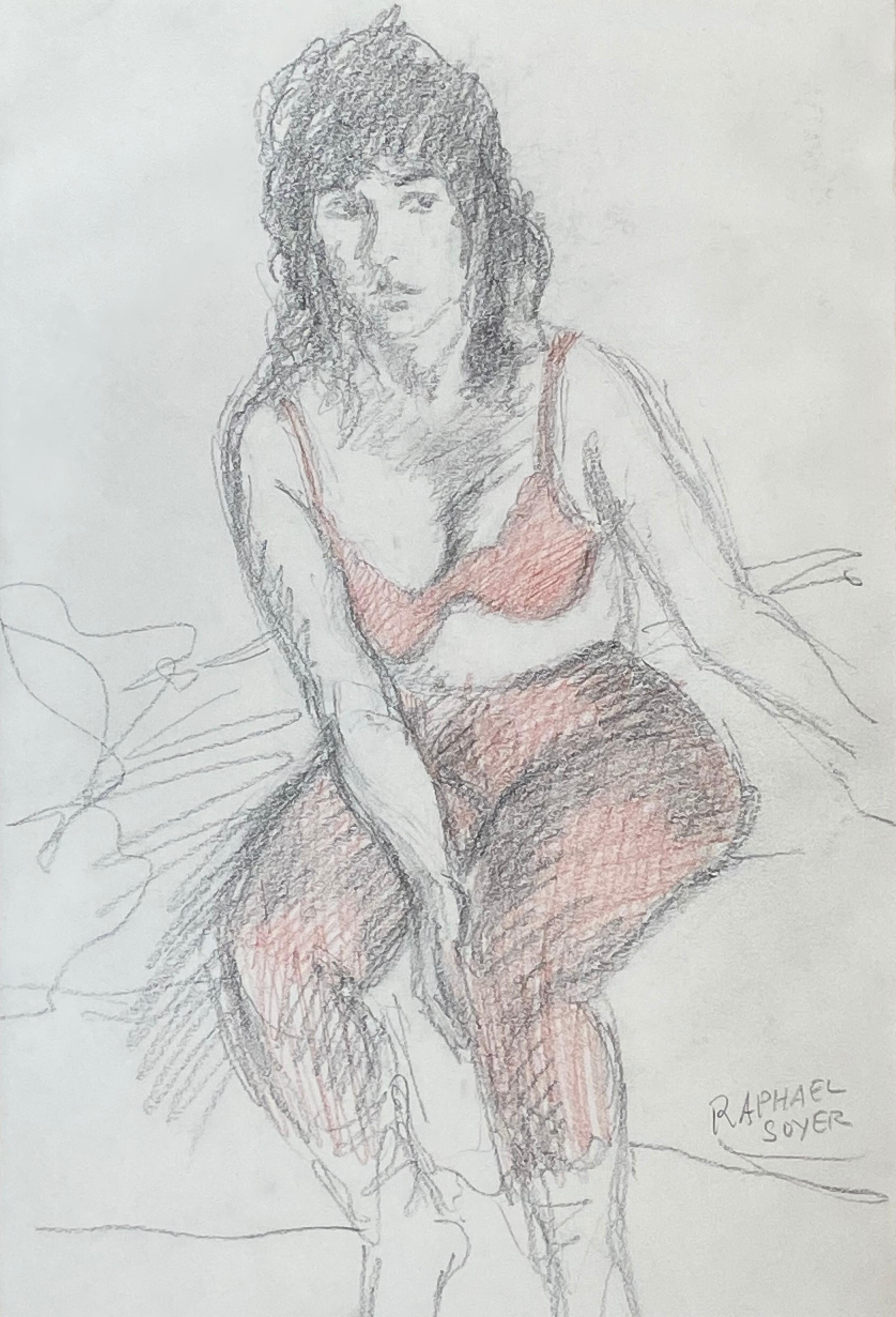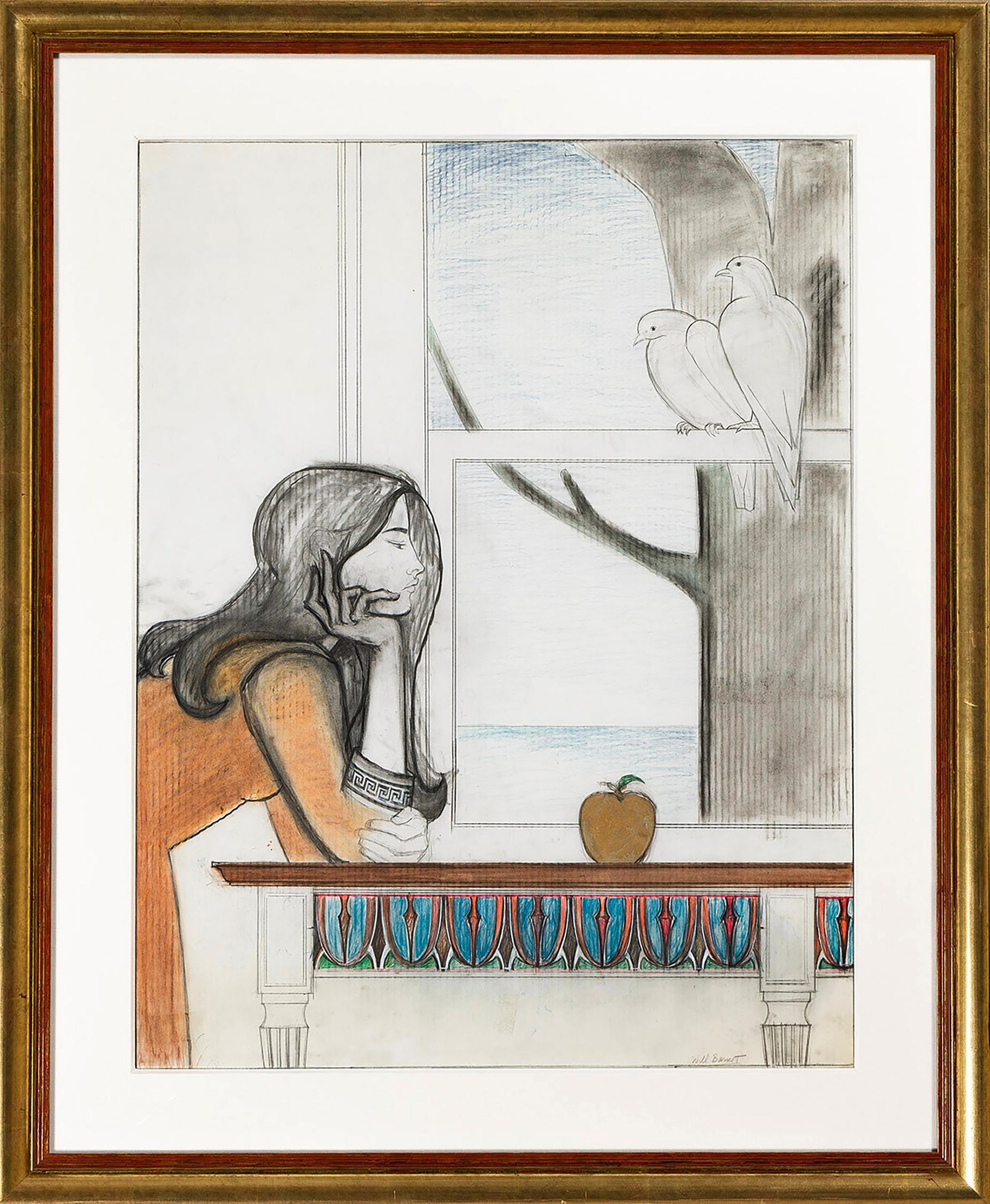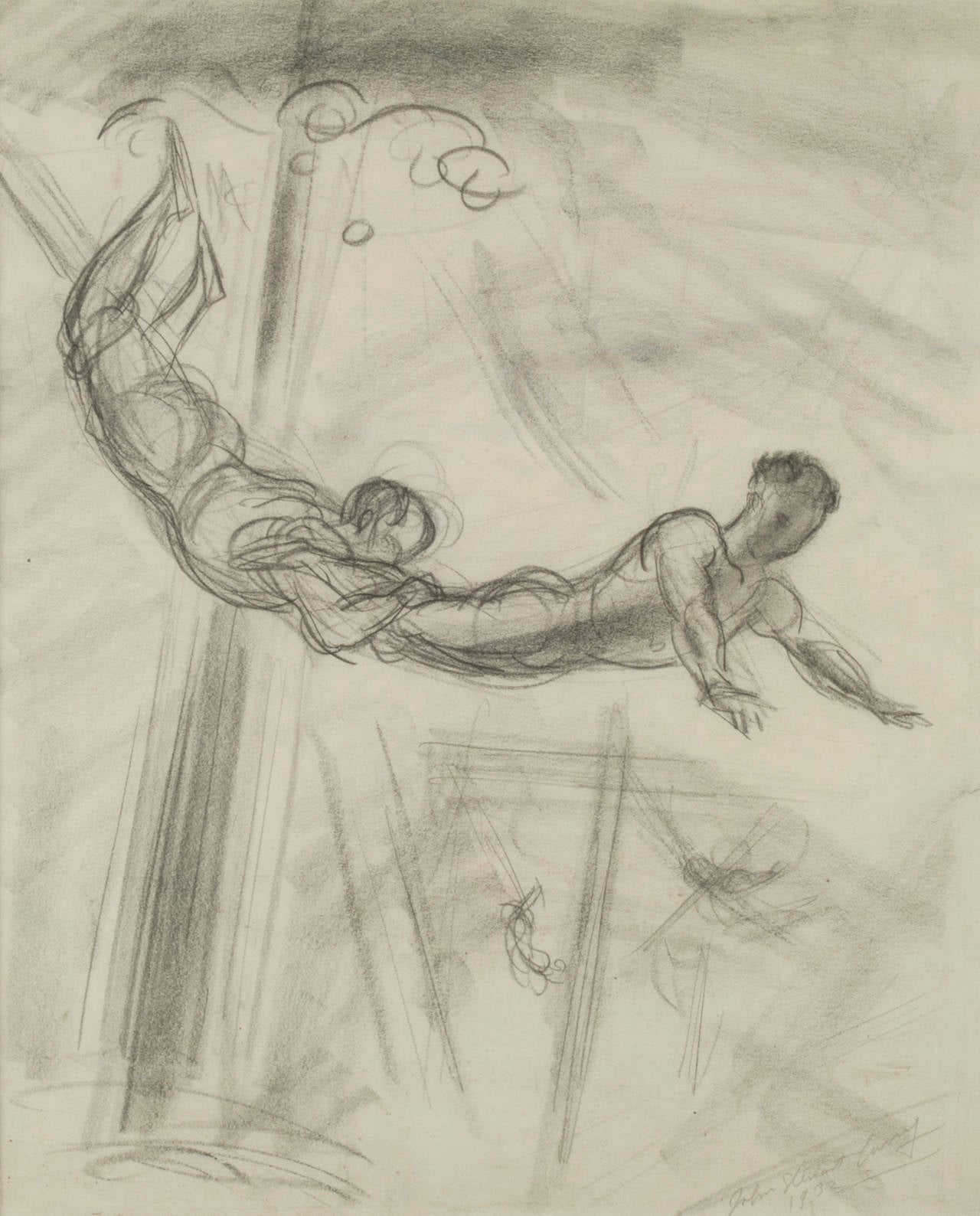Abraham WalkowitzIsadora Duncan1910
1910
About the Item
- Creator:Abraham Walkowitz (1878 - 1965, American)
- Creation Year:1910
- Dimensions:Height: 9.375 in (23.82 cm)Width: 7 in (17.78 cm)
- Medium:
- Movement & Style:
- Period:
- Condition:
- Gallery Location:Fairlawn, OH
- Reference Number:
Abraham Walkowitz
Abraham Walkowitz is perhaps best known for his watercolor studies of Isadora Duncan and the dance. However, Walkowitz laid claim to being the first to exhibit truly modernist paintings in the United States. After 1909, he became an intimate of Alfred Stieglitz's 291 Gallery, and while there became a participant in the debate over modern art in America. Walkowitz was an outspoken proponent of the continuous experimentation in the arts, which was his definition of modernism. As an artist, Walkowitz embodied the changing role of the modernist painter in the United States, as modernism moved from an avant-garde protest against established modes to become an accepted style and tradition.
Abraham Walkowitz was a Russian born, turn-of-the-century immigrant to the United States, who grew up in New York's Lower East Side. He first studied art at the Educational Alliance, the Cooper Union and the National Academy of Design. In 1906, he journeyed to Europe where he studied at the Académie Julian in Paris. Upon his return to the United States in 1907, he became a fully-fledged convert to modernism, and his first exhibit, at the Haas Gallery in that year, brought him a measure of notoriety as well as the attention of Stieglitz and other pioneers of non-objective art. In subsequent years, he became one of the most exhibited painters shown at the 291 Gallery, a fact which was also reflected in the pages of Stieglitz's polemical journal of modernism, camera work. As a result of this early attention, by the time of the Armory Show of 1913, to which Walkowitz contributed several paintings, his work was widely known to both fellow modernists as well as their opponents.
Walkowitz was clearly part of the new vocabulary of American art and criticism. During the 1920s and 1930s, as the first-generation modernists lost their revolutionary cast, and as American realism gained in favor, Walkowitz continued his experiments with form and line, especially in his series of Duncan studies. Although his paintings received less critical attention than they once had, Walkowitz was clearly one of the grand old folk of American modernism. During the depression, Walkowitz was politically active on behalf of unemployed artists supporting various new-deal initiatives in the arts. In the 1940s, Walkowitz gained national attention when he explored the varieties of the modernist vision in the form of an exhibit of 100 portraits of him by 100 artists. The result was widely discussed and was featured in Life magazine in 1944.
In 1945, Walkowitz traveled to Kansas, where he painted landscapes made up largely of strip mines and barns. This was his last venture in active painting — by 1946, glaucoma, which led to his eventual blindness, began to impair his vision and limit his ability to work. Walkowitz then turned to the preparation of a series of volumes of his drawings, designed to illustrate the development of modernism in the 20th century, and in so doing, established his role as a pioneer American modernist.
- ShippingRetrieving quote...Ships From: Fairlawn, OH
- Return PolicyA return for this item may be initiated within 10 days of delivery.
- Untitled (Study for The Aerialists)By John Steuart CurryLocated in Fairlawn, OHUntitled (Study for The Aerialists) Graphite on paper, 1932 Signed lower right in pencil: "John Steuart Curry" Dated: 1932 in pencil Exhibited: Schroeder Romero & Shredder, NYC (label), Master Drawings, Oct. 13, 2011-Nov. 12, 2011 (see photo of label) Arkansas Arts Center (label), 44th Collector Show & Sale, Nov. 30-December 30, 2012, Offered at $22,000. (see photo of label) This drawing is closely related to a painting by Curry entitled The Aerialists, 1932, once in the Erskine Collection, Cedar Rapids, Iowa. It is part of a group of preliminary drawings and three finished paintings executed by Curry around 1932 which were based on The Flying Cadonas. The painting The Flying Cadonas is an icon of American art purchased by the Whitney Museum of Art and now on permanent exhibition. There are other know studies for these works, nos. 199 through 222 and in John Steuart Curry: Rural America, page 32 (Mongerson Wunderlich, Chicago, 1990. Provenance: Mrs. Kathleen Curry (artist’s widow), included in the estate schedule of works Treadway Toomey Auction, Oak Park, Illinois, 2009 Don Joint, New York An important American Regionalist drawing. Like Grant Wood and Thomas Hart Benton, John Steuart Curry was a major American scene painter of the 1930s. His subjects were taken from American history and his most famous mural, The Tragic Prelude...Category
1930s American Modern Figurative Drawings and Watercolors
MaterialsGraphite
- Pablo CasalsBy August F. BiehleLocated in Fairlawn, OHPablo Casals Graphite on paper, 1963 Signed in pencil lower right (see photo) Sheet size: 11 5/8 x 8 inches Condition: glue residue in all four corners of the sheet Drawn from life during an appearance at Carnegie Hall with the Cleveland Orchestra...Category
1960s American Modern Figurative Drawings and Watercolors
MaterialsGraphite
- Seated CoupleBy Raphael SoyerLocated in Fairlawn, OHInspiration (Seated Couple) Graphite on paper, c. 1967 Signed twice in pencil by the artist on recto (see photos) Condition: Excellent Image size: 13 x 16 inches Note: Although not t...Category
1960s American Modern Figurative Drawings and Watercolors
MaterialsGraphite
- Reclining Female NudeBy Emil GansoLocated in Fairlawn, OHReclining Female Nude Charcoal on paper, c. 1933 Signed lower right (see photo) Provenance: Weyhe Gallery, New York (Ganso's dealer 1925-1941) Joseph Mark Erdelac, Cleveland, noted collector who had a large collection of Ganso works Ganso was born in Germany in 1895. At age 14, he apprenticed to a baker and then worked his way to America when he was 17. He worked in bakeries in Scranton, Pennsylvania; and Cincinnati and Akron, Ohio. By 1916, Ganso out of a job, and was living the life of a bohemian in New York City, sometimes on less than 30 cents a week.1 In 1921, Ganso painted a realistic nude on a bedsheet, and was forced by the police to remove it from an exhibition. The bedsheet with the painting was later stolen. He soon had a job baking again at $140 a month, and with time to spare for painting and study. Ganso quit baking in 1925 when a New York dealer gave him financial backing of $50 a week. Ganso prospered from his art after that. His work is in over 15 American museums, and the Print Club of Cleveland awarded him a $500 purchase prize for a wood engraving. A versatile artist, he painted a variety of subjects. (from a profile written by Clyde Singer...Category
1930s American Modern Nude Drawings and Watercolors
MaterialsGraphite
- Volunteer Firemen, ProvincetownBy E. Ambrose WebsterLocated in Fairlawn, OHPreparatory drawing for Volunteer Firemen, Provincetown Graphite on paper, 1932 Initialed in pencil by the artist lower left: W Provenance: Estate of the artist, 1935 Georgianna Webs...Category
1930s Modern Figurative Drawings and Watercolors
MaterialsGraphite
- Bull engaging the muleta (Bull Fight)By Robert HallowellLocated in Fairlawn, OHBull engaging the muleta (Bull Fight) Signed with the Estate stamp lower left (See photo) Provenance: Estate of the Artist Marbella Gallery Inc., NYC Refer...Category
Mid-20th Century American Modern Animal Drawings and Watercolors
MaterialsWatercolor
- “Seated Model in Red Bra”By Raphael SoyerLocated in Southampton, NYOriginal graphite and colored pencil drawing on archival paper of a woman seated in a red bra by the well known American artist, Raphael Soyer. Signed lower r...Category
1950s American Modern Figurative Drawings and Watercolors
MaterialsGraphite, Archival Paper, Color Pencil
- Final Study for Atalanta, Girl with AppleBy Will BarnetLocated in Greenwich, CTWill Barnet is one of America's best loved and known artists of the Post War era. He is highly distinctive for his figurative and narrative work and in some ways he is the Edgar All...Category
1970s American Modern Figurative Drawings and Watercolors
MaterialsWatercolor, Graphite, Color Pencil, Vellum
- "Sons and Lovers" Drill Drawing, #5By Michael O'KeefeLocated in Dallas, TXSigned by artist "M. O'KEEFE 2013" at lower left. Media is graphite on clay-coated panel. Overall dimensions including the frame are 18 x 15 inches.Category
2010s American Modern Figurative Drawings and Watercolors
MaterialsClay, Panel, Graphite
- "Woman in Fancy Costume Estate #752, " Watercolor & Graphite signed by SpicuzzaBy Sylvia SpicuzzaLocated in Milwaukee, WI"Woman In Fancy Costume Estate #752" is a watercolor and graphite signed by Sylvia Spicuzza. A woman stands with arms stretched out. The lady is wearing a red and white stripped outf...Category
1950s American Modern Figurative Drawings and Watercolors
MaterialsGraphite, Watercolor
- Sketch for Mural, Figure on Horseback in Black and White Original DrawingLocated in Denver, COUntitled graphite on paper drawing by Verona Burkhard (1910-2004) of a figure on horseback. Preliminary sketch for a later completed mural. Presented in a custom frame with all archival materials, outer dimensions measure 29 ¾ x 22 ¾ inches. Image size is 23 ½ x 16 ¼ inches. Expedited and international shipping is available - please contact us for a quote. About the Artist: Verona Lorriane Burkhard was born on June 8, 1910 to of Henri and Verona P. (Turini) Burkhard, both of whom where artists. She was raised in New Jersey and New York where she studied at the Art Students League under Boardman Robinson and Columbia University under Frank Mechau...Category
20th Century American Modern Animal Drawings and Watercolors
MaterialsGraphite
- Characters from the Sketchbooks (from September Storm plus Self Portrait)By Jackson Lee NesbittLocated in New Orleans, LAThis is a page from the artist's sketchbooks. Six pencil drawings show figures that might have been in preparation for future lithographs, Certainly the woman with the umbrella could have been an early iteration for September Storm. There is also a self portrait of Nesbitt. Clearly the works are authentic if unsigned. Provenance: from the Nesbitt studio. From workers wrestling with heavy machinery to a lone horseman traveling down a rut-filled country road; from the animated crowd at a livestock auction to the dignified worshippers at a serene Sunday service; Jackson Lee Nesbitt chose to represent the essence of humanity and the nobility of ordinary folk striving to get along as best they can. He studied with Thomas Hart Benton and John Demartelly...Category
Late 20th Century American Modern Figurative Drawings and Watercolors
MaterialsGraphite






